
It sounds unbelievable, but each day around 20 percent of clean water produced in the world is lost as the result of leaky pipes. According to the American Society of Civil Engineers, this amounts to an estimated 6 billion gallons of clean water per day in the U.S. alone. The problem is exacerbated by current detection technology, which means that most of the leaks are either not found or discovered too late, after they’ve already caused sinkholes and burst pipes.
A new soft robot may be able to help, however — and it’s just netted the 2018 James Dyson Award, a design competition to celebrate up-and-coming inventors. The award-winning creation is the work of recent Massachusetts Institute of Technology (MIT) doctoral graduate You Wu. Called Lighthouse, the low-cost bot is designed to travel through water pipes on the hunt for leaks before they turn into major problems.
All a technician needs to do to use Lighthouse is to insert it into a water pipe by way of an existing hydrant. It then passively flows through the pipe, navigating around pipe elbows, discovering leaks due to the suction force of the puncture. It then measures the strength of the suction and records details of its location. The technician can then retrieve the robot when it’s flushed out of the pipes through a hydrant, and wirelessly download a map of leaks.
“Winning the James Dyson Award is a great recognition of my six years of effort to solve the world’s water loss problem through engineering and design,” Wu told Digital Trends. “This summer, I built my company, WatchTower Robotics, with the technology coming out of this project. The James Dyson Award is bringing publicity to my company at the perfect time. It will connect us with potential customers, team members, partners, and investors. Moreover, it will help us educate the public that the 20 percent water loss is a real and common problem — and now we have a technology to address it effectively.”
U.S. runners-up for the James Dyson Award include Infinite Cooling, a technology that recovers large quantities of clean water from power plant cooling tower plumes, and Night Loo, a portable, personal urinal for women and girls living in refugee camps.
Editors' Recommendations
- Part Terminator, part Tremors: This robotic worm can swim through sand
- Repair robot swims through oil pipelines and welds cracks — without exploding
- MIT’s snake robot is designed to crawl through blood vessels in the brain


